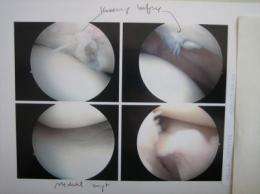Amniotic membrane used to repair human articular cartilage

Spanish scientists have proposed using human amniotic membrane as a new tool for repairing damaged human articular cartilage, which heals very poorly because of its low capacity for self-repair. Their research, published in the journal Cell and Tissue Banking, shows that the cellular density of the cartilage synthesized could be greater than that of the body's own natural cartilage.
"The objective was to evaluate the utility of cryo-preserved human amniotic membrane (HAM) as a support for repairing human articular cartilage injuries, which have a very limited capacity for self-healing", Francisco J. Blanco, lead author of the study and a researcher at the Institute of Biomedical Research of La Coruna (INIBIC), tells SINC.
The results, which have been published in the journal Cell and Tissue Banking, show that cryo-preserved HAM is useful as a scaffold for growing human chondrocytes in cell therapy and for repairing human cartilage injuries. "It provides a more regular surface and fills in the cavities and fissures", explains Blanco.
The authors cultivated the chondrocytes (cells that form part of the cartilaginous tissue), isolated from human articular cartilage, on the amniotic membrane over a period of three and four weeks. The amniotic membranes were used to develop 44 repair models of arthritic human articular cartilage in vitro, which was assessed between four and 16 weeks later.
The HAM also bonds well with the native cartilage. "In some models, we could not differentiate between where the native tissue stopped and the neo-synthesised tissue began", says the expert. This tissue had a fibrous appearance and high cellular density (cellularity), which in some cases was greater than that of the actual native cartilage.
The use of differentiated chondrocytes is a useful therapeutic option for repairing articular cartilage injuries. However, there are limitations to implanting these cells, since many patients will be ruled out due to their lack of healthy chondrocytes, and this technique also causes additional damage to the joint.
"Transplanting chondrocytes cultivated on different natural or synthetic 'scaffolds' is used today in cell tissue engineering. The HAM has sparked great interest over recent years, above all in the field of regenerative medicine", concludes Blanco.
Clinical solutions to osteoarthritis
Osteoarthritis (OA) is a major articular pathology that is characterised by alteration of the cartilage and the bone that supports it, the subchondral bone. As the current pharmacological and surgical treatments have only palliative effects, cell therapy is a new clinical approach for repairing damaged or destroyed tissues.
HAM has many clinical advantages as a support - it is an anti-microbial, anti-angiogenic, anti-tumour tissue, which reduces inflammation and pain and improves scarring. In addition, the amnios of the HAM has no immune response, meaning there are no risks associated with transplanting it, and it contains many of the components of natural cartilage.
More information: Silvia Díaz-Prado; Mª Esther Rendal-Vázquez; Emma Muiños-López; Tamara Hermida-Gómez; Margarita Rodríguez-Cabarcos; Isaac Fuentes-Boquete; Francisco J. de Toro; Francisco J. Blanco. "Potential use of the human amniotic membrane as a scaffold in human articular cartilage repair". Cell Tissue Bank (2010) 11:183-195 DOI 10.1007/s10561-009-9144-1















